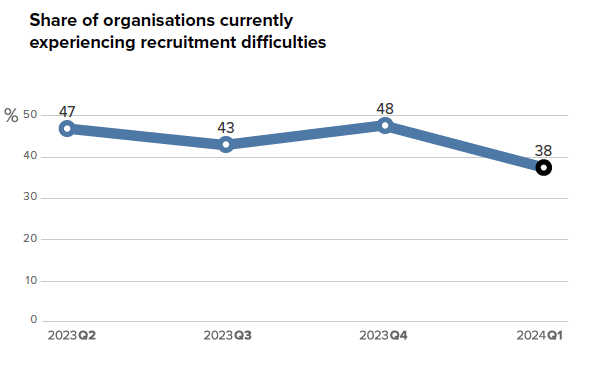March Employment Market Update

Job ads down in March but higher than pre-pandemic levels
According to Staffing Industry Analysts, job advertisements in Australia fell by 10.6% year-on-year in March 2024 on a seasonally adjusted basis. They sited ANZ-Indeed job ads data which showed job ads fell 1.0% month-on-month in March. In trend terms, the series was down 0.4% over the month.
Despite the annual fall of 10.6%, ANZ-Indeed job ads were 32.1% higher than in 2019.
ANZ Economist, Madeline Dunk said, “The pace of declines in ANZ-Indeed Job Ads has eased...While we expect to see a further moderation in job ads, the recent stickiness in the series implies it is unlikely to be a linear path downward and suggests we will only see a gradual rise in unemployment,” Dunk said.
Indeed's Senior Economist, Callam Pickering said “Tech hiring remained subdued in March, with Job Ads for software development, IT operations, and information design falling once again,” Pickering said. “Job ads for these tech sectors are down by between 31% and 39% over the past year.”
“Real” wage increase expected once inflation eases
According to AHRI’s news website, HRMOnline, the basic mean pay increase is expected to be 3.7 percent in the 12 months to January 2025, AHRI data finds. Plus, the research reveals employers’ recruitment and redundancy intentions for the current quarter.
AHRI’s most recent Quarterly Australian Work Outlook report, which measures sentiment from 600+ senior HR professionals and business decision-makers across private, public, and not-for-profit sectors, reveals that net employment intentions have fallen from +41 in the December 2023 quarter to +33 in the March 2024 quarter.
While concerns about future economic conditions may be behind this drop, it was interesting to see that these concerns have not resulted in increased intentions to cut jobs. Redundancy intentions fell from 31 percent in the previous quarter to 22 percent for the March quarter.
Recruitment and pay insights
Nearly 4 in 10 (36 percent) employers are planning to increase staff levels in the March 2024 quarter, which is a slight decrease from the previous quarter (45 percent), suggesting that the employment market has somewhat softened.
At the same time, recruitment intentions have remained unchanged (71 percent) over the same period, suggesting that recruitment activity is more about replacing staff than adding to the workforce.
Our research reveals a reduction in the number of organisations grappling with recruitment challenges in the current quarter, with 38 percent of employers experiencing recruitment difficulties, down from 48 percent in the previous quarter.
However, it’s important to acknowledge that despite this positive shift, which may be due to lower recruitment activity, recruitment continues to pose significant issues for many organisations.

There has also been an increase in mean basic pay, which is expected to increase 3.7 percent in the 12 months to January 2025. In the previous quarter, respondents told us that they anticipated a 2.6 percent increase in the 12 months to October 2024. This suggests that employees could be in line for sustained real wage growth this year as the Reserve Bank predicts interest rates will drop to 3.3 percent by June 2024. (At the time of writing, rates sat at 4.35 percent).
At the same time, many organisations are still finding it challenging to access the talent and skills they need. A lack of quality in the labour supply and the high training and recruitment costs associated with replacing staff may still be putting upward pressure on wages in some workplaces.
1 in 4 employers have turnover above 20%
According to HRMOnline, a quarter of organisations are still reporting turnover rates above 20 percent. For comparison, some people suggest that a ‘healthy’ turnover rate would sit below 10 percent, but it would be highly dependent on the industry and organisation.
To manage their recruitment challenges and ease skills shortages, employers are focusing on upskilling and internal mobility, with 36 percent creating further learning and development opportunities in a bid to retain key talent.
Unsurprisingly, flexible work arrangements were cited as the main lever in a retention strategy (37 percent), but improved employee wellbeing (35 percent) and coaching and mentoring opportunities (33 percent) were also common responses.
It was also encouraging to see that nearly a quarter of respondents (23 percent) are planning to invest in uplifting leadership and management capabilities.
78% increase in demand for payroll services
Dixon Appointments job data showed a 78% increase in payroll service requests from our clients for QTR 2 and 3 when compared to the same time in 2022/23 financial year.
Anecdotally, our clients have stated that there are a couple of key influences driving this, most commonly a business decision to outsource their casual engagements due to legal and commercial challenges.
With the forthcoming changes resulting from the Closing Loopholes Bill, we expect these pressures to continue.
Referring known candidates to your preferred recruitment agency to on-hire to your business has many other benefits, too:
-
Better candidates
-
Rapid onboarding
-
Improved candidate experience
-
Reduced cost
-
Improved retention
You can read more about payroll service here, or reach out to your recruiter for more information.